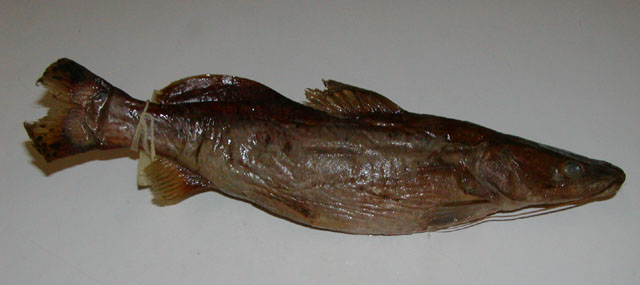| Bagridae (Bagrid catfishes) |
| 150 cm SL (male/unsexed); max.weight: 9,500.0 g |
|
demersal; freshwater; depth range 0 - 60 m |
| Africa: Endemic to Lake Malawi. |
|
Dorsal spines (total): 1-1; Dorsal soft rays (total): 9-10; Anal soft rays: 14-15. Head depressed, smooth or finely striated above; snout not or little projecting beyond lower jaw; premaxillary band of teeth 5-6.5 times as long as broad, nearly as broad as the band of vomerine teeth; maxillary barbel 2(juv.)-1 times head length, reaching to extremity of pelvics or beyond (<200mm), to extremity of pectoral (300-500mm) or hardly beyond gill-opening (>500mm); nasal barbel 2/5 (<100mm)-1/7 (>500mm) head length; outer mandibular barbel 3/4(juv.)-2/5 of head length; inner mandibular barbel 1/2(juv.)-1/5 of head length; gillrakers rather long, widely set (Ref. 52162). Occipital processus long and narrow (Ref. 52162, Ref. 2988). Dorsal fin short, last ray above or just in front of first ray of pelvic; dorsal spine smooth, feeble (Ref. 52162). Adipose fin large (Ref. 52161), 5(juv.)-11 (>600mm) times as long as deep (Ref. 52162). Dorsal fins widely separated (Ref. 4967, Ref. 2899), space 2/3-1 times length of base of rayed dorsal fin; pectoral spine smooth or very slightly serrated; caudal fin deeply forked with pointed lobes (Ref. 52162).
Coloration: brown or olive above, pale beneath, black dots or blotches scattered irregularly on the back, on the adipose dorsal and caudal fins, and sometimes also on the rayed dorsal (Ref. 52162). |
| Occurs from the lower reaches of rivers to the deepest habitable parts of the lake (Ref. 4967). Inhabits a variety of habitats (Ref. 52142). Feeds on small demersal cichlids (Ref. 52142) during the night (Ref. 5595). Juveniles mainly feed on trophic eggs released by the female (Ref. 36945), whilst the male helps the young in searching for invertebrates in and around the nest (Ref. 36945). Mutualistic relationship with cichlids concerning defense and feeding of young of both the cichlid and B. meridionalis (Ref. 52146). Symbiotic relationship of parasitized host-parasite eater exist with Pseudotropheus crabro, which eats away necrotic tissue and parasites, but also steals eggs (Ref. 42778). Oviparous (Ref. 205). Can produce sound as Amia or Synodontis species (Ref. 42447). Considered as a delicacy when smoked, making it one of the most highly priced fishes of Malawi (Ref. 52150). |
|
Critically Endangered (CR); Date assessed: 23 May 2018 (A2d) Ref. (130435)
|
| harmless |
Source and more info: www.fishbase.org. For personal, classroom, and other internal use only. Not for publication.

